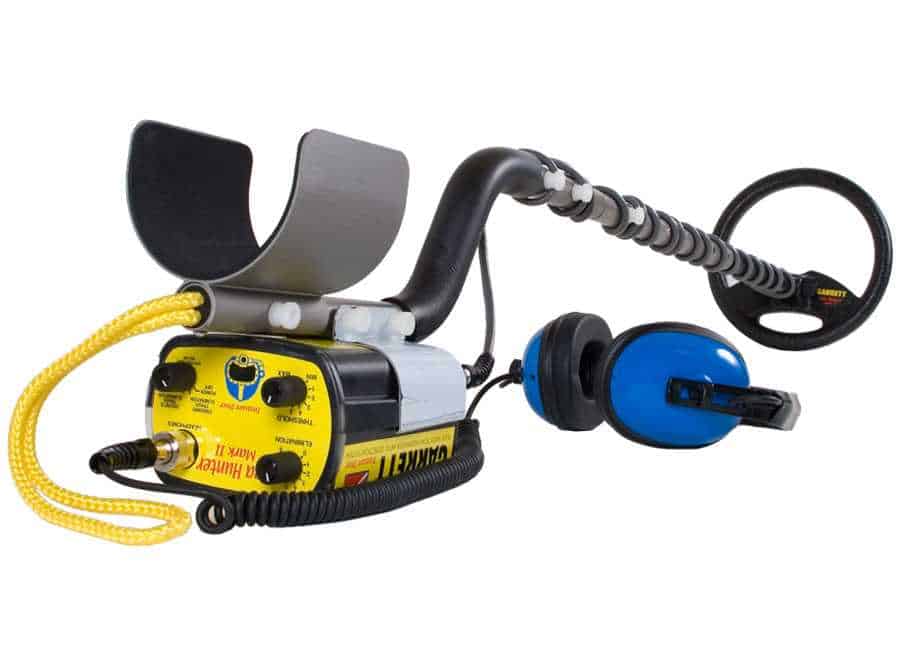Field Test: Garrett Sea Hunter Mark II Metal Detector Review
Published by Colonel Dan on 07/30/19
Experienced pulse induction detectorists know well that those machines have little to no discrimination capability. Its either a target hit on everything metallic or nothing…and they characteristically go “deep” for all targets within range be they bobby pins, bottle caps, coins or gold rings.
I’ve always been a VLF man so I decided to experiment with the Garrett Sea Hunter just to see for myself how well its discrimination modes worked. I chose the Garrett Sea Hunter because it has a well deserved reputation as being both a solid performer and a ruggedly reliable detector.

Garrett Sea Hunter
Additionally, it is one of the few actually designed with a discrimination capability. What I read about this function ran hot and cold with most users reporting that yes, you can indeed discriminate out some iron based targets unlike many other PI detectors but doing so costs you detection depth. In short, I found out for myself those reports are right. On a side note, Blake Hattaway of Kellyco sales hit the bullseye when I picked up the Garrett Sea Hunter for testing, telling me that he wouldn’t go above level 5 on the discrimination scale! This man simply knows his metal detectors!
The next day, I set up a test using 7 different good targets: a thin 22k band bracelet, four rings varying in size and carat composition from 10-18k, and two coins—a dime and a quarter. For my junk targets I used the infamous bobby pin and the ever present bottle cap.
In the standard discrimination mode with elimination set at zero, which is essentially no discrimination, all targets were detected at my testing depth of 6 inches. I then began increasing the discrimination level to determine at what setting the target was lost. In general, I found that target size mattered more than composition. At the extremes, I found small ladies rings were lost above a setting of 3-4 while the large bracelet was lost at 7-8. The two coins were lost between 5-7 on the scale.
I next turned to my real interest in this test—discrete elimination.

Wedding Ring Field Test
Again, the target size seemed to be the determining factor. The smallest ring was lost at 1.5 while the others barely rang out at 5. The larger man’s wedding ring and bracelet were lost between 6-7. Interestingly enough, my large Army class ring was never lost even with the ring 6 inches deep and the knob set at full discrimination!
As for the junk targets, the bobby pin on the surface was lost at 4 while the bottle cap wasn’t lost until I reached a setting of 6. At test depth, the bottle cap was detectable until I reached a level of 4-5 when it finally faded away. The bobby pin at depth was lost at around 2 or even less.
Given those results, were I to adjust the discrete mode high enough to eliminate the bottle caps, I would lose the smaller rings and just barely hit on the larger targets—my Army ring being the exception.
Summary
The reports from Garrett, the forums and their related videos…and Blake…were right. The more you crank up the discrimination the more you lose depth and that loss is compounded when the target is small. If you’re primary interest is in eliminating junk and only digging a few inches or going after super bowl rings, by all means crank up that discrimination knob. However, I obviously concur with both Garrett and the others; the best setting for the Garrett Sea Hunter Mark II is the lowest level of discrimination possible in standard mode. To get the most out of the Garrett Sea Hunter and being reasonably confident of not passing over potentially good targets, I’d start off with zero discrimination and prepare myself to dig a lot! In this setting, the Garrett Sea Hunter is a solidly performing waterproof PI machine at a great price point. But as I always say, that’s just the view from my foxhole. Your results may vary.
Garrett Sea Hunter Mark II
Garrett’s Sea Hunter Mark II has been one of the best underwater detectors for over 25 years. It can ignore most trash, including pull tabs and foil, without degrading the sensitivity of rings and coins in Discrete Elimination mode. It includes underwater headphones and an electronic housing that can be mounted at different locations (including on your hip). This detector cancels salt and ground mineralization with pulse induction circuitry.
- Weight: 5.1 pounds
- Frequency: PI — 750 pulses per second
- Waterproof: Submersible up to 200 feet
- Warranty: 1-year limited

- Affordable pulse induction machine (one of the least expensive PI machines on the market)
- Waterproof to 200 feet
- Non-motion deep-seeking mode for diving
- The discrete Elimination mode is not as advanced as some other machines
- A little heavy at over 5 pounds (but not too bad if used underwater)
- There is no coil cover for the 8” coil
- Waterproof. Easy to use? Gold and silver rings jump out at you. Dry sand. Or chest deep water. Great machine. Oh by the way. Coin shooters and relic hunters if you are a beep and dig guy as I am. This is your machine as well. Gold prospector? This is it. I've found pickers with this on my land in the north Georgia mountains. I live a block from the beach in Panama City Beach Florida. I have land in the mountains. This is a go anywhere, do anything machine. - James Z.
